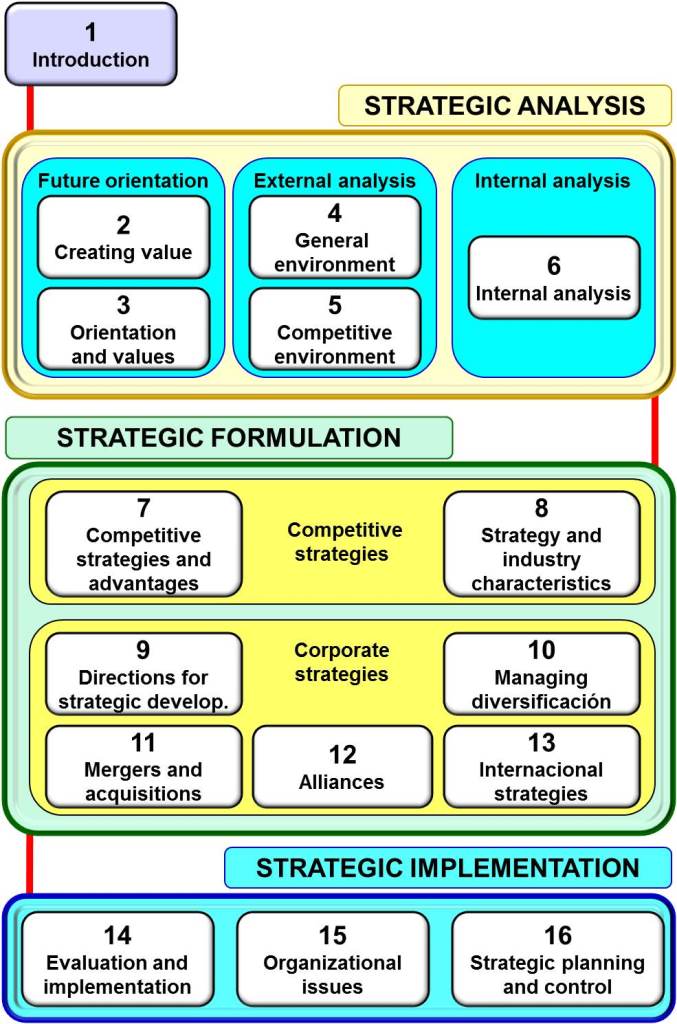The book is structured in three parts: Strategic Analysis, Strategy Formulation and Strategy Implementation. Each part is divided into blocks that, at the same time, are subdivided in the different chapters that make up each block, as can be observed in the figure.

Chapter 1 is introductory and intends to present the fundamentals of what is understood as Strategic Management. It thus establishes the concept of strategy and the difference between the different levels mentioned above: corporate, business and functional. The different phases of the process are also analyzed using a strictly rational approach to decision-making.
After this introduction, the first part of the book begins with Strategic Analysis. In this part and in the first place (chapters 2 and 3), the problem of the future orientation of the firm is studied. The first question raised is related to how to measure business performance. In second place, we deal with the problem of who fixes the objectives, in reference to the existence of other special interest groups or stakeholders, especially managers, different from the owners, and the possibilities of the latter to control them, a problem known as corporate governance. Especially relevant in this section are the mission, vision and strategic objectives for the identification of general plans for business performance. This section concludes with a consideration of the managerial values manifested by the assumption of the principles of corporate social responsibility and ethical behaviour.
Strategic Analysis contains another two blocks: external and internal analysis. External analysis investigates the environmental factors that affect business performance (chapters 4 and 5). At the same time, within external analysis, a distinction is usually made between the general and specific environment. The former studies the factors that, from a generic point of view, influence managerial behaviour. The latter refers to the competitive environment; that is, in accordance with the industry, that is, the type of activity the business carries out. This conceptual separation arises from the different methodology of the analysis behind each one: a study of the general environment requires techniques such as a strategic profile of the environment, Porter´s “diamond” and the industrial districts, while the specific environment uses Porter's five forces analysis, industrial segmentation in strategic groups and the analysis of competitors.
Internal analysis (chapter 6) deals with those factors that are characteristic of the business and that, therefore, fall under its power of decision. The techniques of analysis dealt with are: business identity, the strategic profile, the value chain, benchmarking, and SWOT analysis. We should highlight the importance of the analysis of resources and capacities in this field, as a theory to explain the reasons why different businesses that perform in the same industry present different competitive advantages.
The objective of this first part is to identify the environmental opportunities and threats for business performance as well as the strengths and weaknesses. In this way the foundations are laid for the establishment of different strategies.
The second part of the book deals with Strategy Formulation. The diversity of qualifying criteria with regard to strategic alternatives is significant. For this reason, we have opted for the use of differentiation by levels of decision, distinguishing between corporate levels, strategies at the level of the business and functional strategies.
It is important to conceptually distinguish these levels since they imply different decisional situations. At the corporate level, general questions, referring fundamentally to the definition of the scope of activity and to the different types of development, are raised. At this level, a global vision of the business is therefore necessary as a starting point for the possible identification of business opportunities and consequent decision-making.
At the business level, the main problem is how to be more competitive and successful in concrete businesses, once they are defined. At this point, decision-making is related to the type of activity carried out and the identification of the best options to compete in these activities. Lastly, at a functional level, the decisions to be made are related to the functional areas of the business, that is: production and technology, financing, marketing, purchasing and human resources.
In the section on Strategy Formulation , only corporate and business strategies are taken into consideration, although a brief reference is made to functional strategies in the strategic implementation part. Strategies at the business level are included in the block of chapters 7 and 8, where competitive strategies, strategies based on industrial characteristics and strategies for technology-based industries are examined.
All these strategies attempt to identify the possibilities of business performance in order to better compete on the marketplace, in search of competitive advantages that allow the business to isolate itself from competitors and consequently obtain higher returns. Chapter 7 deals with the important question of obtaining sustained competitive advantages in order to obtain higher profitability. After an introduction dealing with the main components of competitive advantage and the its creation and maintenance, an in-depth inquiry into the two classic advantages proposed by Porter is made: cost leadership and product differentiation. This analysis is completed by expanding the original model in order to identify hybrid situations to compete. Finally, a brief reference is made to business models and blue ocean strategy.
In chapter 8 we explore possible strategies to follow in accordance with the characteristics of the industry in which the business carries out its activity. A first criterion is proposed in accordance with the life cycle of the industry, the usual distinction between emerging, growing, mature and declining industries arises. For each of these types, we explore their most relevant characteristics and propose the most adequate strategies. We also examine in this chapter strategies to compete in technology-based industries, considering the following aspects: the effects of technology on the evolution and structure of industries, the most relevant characteristics and competitive and corporate strategies to compete and develop in this type of industries.
Corporate strategies are examined in the block that includes chapters 9 to 13: strategies for business development -expansion and diversification-, ways and methods for development -internal and external development-, alliances or cooperation between businesses and internationalization strategies.
Development strategies refer to the appropriateness of continuing to operate with the same products and/or markets or enter, using diversification processes, into new businesses. These strategies are dealt with in chapters 9 and 10, where the principal motives to follow one or another, as well as the different types are analyzed. We also take into account development strategies that do not imply business growth, as in processes of the restructuring of existing businesses or of business portfolios.
Special attention is paid to business diversification, a frequent strategy in the real world and which poses serious challenges both in its conception and for the management of diversified businesses. Therefore, in chapter 9, we focus on the different types of diversification and their most outstanding advantages and drawbacks. Chapter 10 makes an in-depth inquiry into problems related to the management of a multibusiness firm, such as the definition and use of strategic business units, whether to define a corporate strategy, the role of the headquarters or the basic management models in this type of firms and the use of strategic matrixes to manage diversified firms.
Likewise, chapter 11 and 12 examine the methods of business development. The first of the two chapters deals with internal (organic) and external development strategies. As to external development, that is, merger and acquisition (M&A) processes, we include a study on the different types, their advantages and drawbacks, the choice of the target business, and cultural, organizational and productive integration.
Chapter 12 deals with cooperative agreements or alliances as an intermediate option between organic and external development and between vertical integration and market transactions. We analyze their advantages and pitfalls, the different kinds of alliances and the problems related to how to manage cooperative agreements.
Finally and within this block, chapter 13 deals with the internationalization strategy, analyzing the concept of multinational firm, the reasons for internationalization, the factors and strategies for global industries, the ways to enter foreign markets and the specific problems of the multinational firm, with reference to aspects such as location, commercial and cultural factors, management of human resources and structural design.
The third and last part of the book is devoted to Strategy Implementation and deals with the processes of evaluation, selection, implementation, planning and control of strategies. Chapter 14 examines the evaluation and implementation of strategies. As to the first question, criteria for appropriateness, feasibility and acceptability are used. For the latter, problems concerning strategy implementation and organizational change are introduced, highlighting four main aspects: organizational design, managerial systems and leadership, human resource management and corporate culture.
These four aspects are dealt with in more detail in chapter 15 . The first aspect refers to how the organizational structure facilitates or harms the implementation of a particular strategy, at both the corporate and business level. The second one deals with the skills and characteristics that management requires to carry out implementation. The third aspect analyzes the role of the human factor in the success of the strategy and the related need to define a specific policy in that respect. The fourth underlines the role of culture as an accelerating or delaying factor of change that implies putting the strategy into practice.
In the last place, chapter 16 inquires into planning and control systems that complete the process of Strategic Management. Planning is precisely the system through which this process is formalized and which allows for the elaboration of the strategic business plan. As a part of strategic planning, a brief analysis of functional strategies is carried out, including production, financial, commercial and supply strategies, since the rest have been taken into consideration in other parts of the books.
The design of the strategic control system, necessary for the evaluation and follow-up of the entire process, completes the model. In this respect, characteristics, methods and informative needs to put strategic control into practice are studied, as well as the specific problems in this context such as the measurement of business results, the control of organizational units and the information system for strategic control.
All of the chapters contain practical examples of the application of the most interesting aspects to business reality. These applications refer to well-known Spanish or foreign businesses operating in Spain. These examples attempt to illustrate the theoretical contents, revealing the reality of the businesses. The book concludes with a bibliography that includes references cited in the text. |


